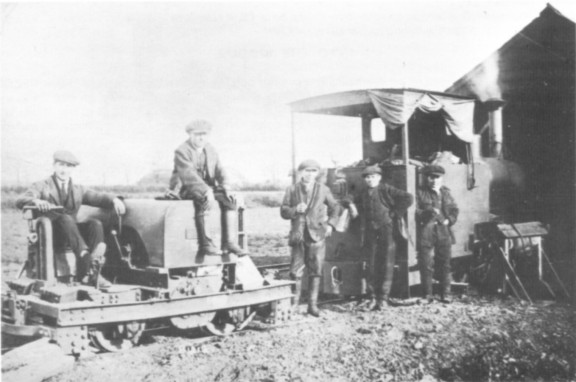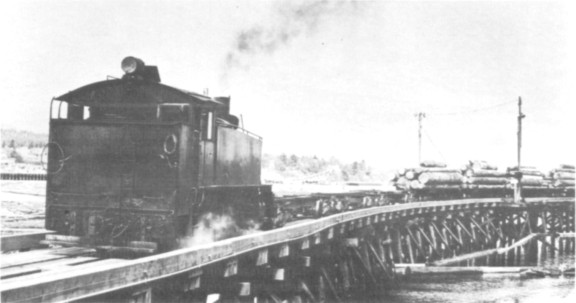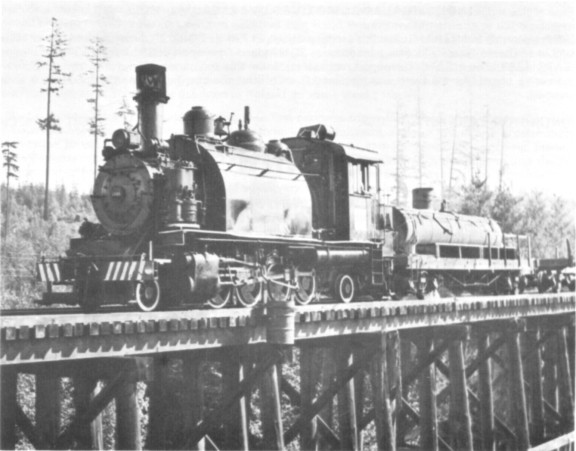![]()
| THE INDUSTRIAL RAILWAY RECORD |
© FEBRUARY 1971 |
![]()
Following a visit to Mr F.C. Griffith, the railway author and photographer, I am able to amplify and correct my article in RECORD 18. The system which I described would seem to be Alton Road not Weydon Hill sand pit. Of the three Farnham locations owned by Ballast Producers Ltd. as given in Pocket Book C, two (Alton Road Gravel Pit and Weydon Hill Sand Pit) had three Simplex locos each whereas Alton Road Sand Pit had but one. Again, the Pocket Book shows Thomas Patterson & Sons Ltd as the former owners of Weydon Hill pit and Mr Griffith spoke of Patterson’s pit "behind Wrecclesham village". This location, which had a standard gauge siding from the Southern Railway Alton line, was visited by a party of enthusiasts (possibly from London) about 1950. Both this and Alton Road Gravel Pit (just behind the roundabout at the western end of the Farnham bypass), which had a siding from the other side of the main line, would have been further than "afternoon walking" distance from my home as a child. All three rail systems closed in 1952−3. At the time of writing, the standard gauge siding serving Alton Road Sand Pit remains intact, although disused for twenty years, and the pair of treetrunks which supported the end of the rail tipping gantry still stand. Most of the area (now filled by tipping) is a wilderness but a cluster of garages have been built on the site of the lorry loading dock. Amongst Mr Griffith’s photographs were portions of local 6in maps believed to date from the late 1920s. Alton Road Sand Pit and its tramway are shown. A line, presumed standard gauge, descending into a pit by zigzags is marked on the opposite side of the main line. Part of this site is now obliterated by a BR waste tip behind the carriage sheds to which the main line connection remains. Mr Griffith seemed to remember a case of a scrap dealer removing rails from the floor of the pit, i.e. at bypass level.
About ¼ mile eastwards was another tramway, running south from a tileworks to a sandpit which is now covered by houses. It crossed a road on the level and Mr Griffith remembers horses pulling wagons uphill to the pit. Gravity was used for the descent. A low bridge, close to the tileworks, which carried the tramway, may still be seen in a small area of woodland bordering a school playing field. At the eastern end of the bypass, on a site now occupied by a trading estate, was a further sandpit. Its tramway crossed Junction Road on the level to reach a siding beside Farnham Junction, where the Guildford via Tongham branch formerly diverged from the main line. The junction was in a cutting and a wider section remains where the sandpit siding lay.
I would welcome additional information or photographs concerning any of these railways.
| KEIGHLEY, YORKS |
SYDNEY A. LELEUX |
STANDARD GAUGE IN NORTH STAFFORDSHIRE — 1967
In the paragraph dealing with the Brookfield Foundry and Engineering Company on pages 169 and 171 of RECORD 17, mention is made that Kerr Stuart 4388 had 16in x 22in cylinders. I think this must be incorrect for when I measured up this locomotive in 1965 the distance over the cylinder covers was only 14in. My guess is that 4388 has 12in diameter cylinders.
| MARKET HARBOROUGH |
ROGER E. WEST |
(Geoffrey Horsman has kindly checked the Kerr Stuart records which show that 4388 had 12in x 16in cylinders. lncidentally there were two locomotives of the "Witch" class, the first being Kerr Stuart 4272 which was despatched on 23rd August 1922 to the Middlewich Salt Co Ltd in Cheshire — hence the class name: the Kerr Stuart clerk actually wrote "Middlewitch" (sic) in the customer’s column of the ledger! 4272 is described in the Engine Register as a modified "Huxley" class loco, but the modifications were fairly extensive, however. 4272 and 4388 when empty each turned the scales at 15t 9c 1qr — KPP)
It might be worth noting that this ill-starred McEwan Pratt locomotive was in fact an 0−6−0 petrol, and not a 4−wheel diesel as stated in the article on the Lodge Hill & Upnor Railway in RECORD 12 (page 277). No photograph of it has yet turned up, although I have an illustration which could be it. Are there any photographs in existence, I wonder?
| KENILWORTH, WARWICKSHIRE |
C. R. WEAVER |
LEIGHTON BUZZARD LIGHT RAILWAY
Further to my article on page 192 of RECORD 9 I enclose a photograph of one of the steam locomotives which has recently come to light. The workman’s leg partly obscures the plate on the petrol loco but LR xx70 is visible. This I assume to be War Department LR 2570 (Motor Rail 849).
| LEIGHTON BUZZARD |
"MUCH OBLIGED" |

Regarding the photograph of CHESHAM on page 194 of RECORD 29, Brighton Works (LB&SCR) repaired a four-coupled tank locomotive of that name for J. Firbank between 11th December 1893 and 24th December 1893. This followed "a pitch−in near Eridge" during work on the LB&SCR Redgate Mill to Eridge line (two single lines converted to one double line along with various track alterations). Another engine involved on this contract was APOLLO — an 0−6−0 saddle tank repaired at Brighton Works on 22nd June 1894 for £284−11−4.
| TUNBRIDGE WELLS, KENT |
D. L BRADLEY |
CHESHAM
Referring to the photograph on page 194 of RECORD 29, a locomotive named CHESHAM was indeed used by J. T. Firbank on the Rickmansworth to Chesham contract for the Metropolitan Railway in 1899. It was reputed to be a six-coupled saddle tank built by Fox Walker. This could well have been FW 327 of 1876, a 13in six-coupled engine owned by Firbank and originally named DERBY. The CHESHAM illustrated puzzles me completely: the saddle tank is similar in shape to that used by John Fowler about that time but all other details are dissimilar.
| UPPER NORWOOD. LONDON SE 19 |
G. ALLIEZ |
(David Cole also mentions the Fox Walker 0−6−0 saddle tank named CHESHAM which he has as later used on the construction of the South Eastern Railway’s Paddock Wood to Hawkhurst branch, completed in 1893: the livery of the 0−4−0 saddle tank illustrated suggests it to be a Firbank loco. D. H. Townsley thinks that the wheels, brake gear, sandbox and dome cover have a Thornewill & Warham look about them although the saddle tank and chimney do not seem to fit in: he wonders whether it could be a rebuild of a T& W well tank. Frank Jones thinks that the CHESHAM illustrated could be a Fox Walker (although the dome is definitely not FW). or it could be a Black Hawthorn (although the chimney is not): the dome suggests Thornewill & Warham. and the loco might be a T&W rebuilt by FW (or vice versa). CHESHAM it would seem is definitely a hybrid locomotive. —
KPP)
The situation has changed rather dramatically since this article was published on page 169 of RECORD 28. Nearly all of the steam locomotives mentioned have since been retired or placed on standby service. MacMillan Bloedel Limited was for many years the last company in western Canada to use steam locomotives to haul logs from the woods down to the coast for processing. Gradually large diesel trucks replaced the railroad operations. It was found that trucks could be operated more economically and over terrain that the railroads found impassable. On 1st December 1969 Baldwin 2−8−2 saddle tank 1055 (not side tank as in the caption on page 170) hauled the last train load of logs to Ladysmith on Vancouver Island. At the present time MacMillan Bloedel has only one steam locomotive in service — 2−8−2 side tank 1066 — used at Chemainus where the company operates a large sawmill.

MacMillan Bloedel’s 1066 at Chemainus, British Columbia. A Baldwin 2−8−2 side tank (58687 of 1925) it has 18in x 24in cylinders and 44in drivers. (Bob Turner)
Only one other steam locomotive is in regular operation on Vancouver Island. It is a two truck Shay geared engine (Lima 3289 of 1925) owned by the Elk Falls Company Limited and used at their Duncan Bay pulp mill on Northern Vancouver Island.
At Vancouver, on the British Columbia mainland, a diesel has replaced the two Shay locomotives used by Railway Appliance Research Limited. Both of the Shays are still on standby, however, should the diesel need servicing. The 115, illustrated on page 171, was given a brief reprieve when the diesel was shopped for six weeks during February and March 1970.
Two errors appeared in the article. The Esquimalt and Nanaimo Railway on Vancouver Island was dieselized in 1949: and the last steam locomotive to operate on Canadian National’s Vancouver Island branch line was the 2149, a 2−8−0 almost identical to the 2141 mentioned in the article. The 2141 was the last CN steam locomotive on the island, but was not used after the last run of the 2149.

MacMillan Bloedel's 1055 (Baldwin 60942 of 1929) on its last run from Railroad Camp to Ladysmith, 1st December 1969. (Bob Turner)
The Editor enquired about the operating procedure for the locomotives pictured in the article. "Do none of these locomotives work chimney first?" The answer is that they certainly did. The Shays of Railway Appliance Research Limited were used in yard service (as was the Hillcrest Climax No.10), necessitating both forward and reverse (ie pushing and pulling) movements. The other locomotives were operated over lines where no turning facilities were available, forcing them to operate forward in one direction and backwards in the other. There were other reasons for this type of operation as well. Logging railroads operated over very steep grades where the possibility of a runaway train or car was always a threat. By having the locomotive at the head of the train – downgrade or in front of the train – it lessened the chances of cars becoming uncoupled. In addition, by operating the locomotive in this position it kept the boiler water over the crown sheets. As a result, in these circumstances, the locomotives were usually backed downgrade and operated chimney (or "stack") first upgrade. This was not a hard and fast rule however. Another factor of consideration was visibility. The crews – as for example at MacMillan Bloedel’s Chemainus operation – found that better visibility was obtained for certain types of work when the locomotives were faced in either one direction or the other. In fact nearly all logging locomotives were equipped with a pair of wheels both in front and behind the drivers to facilitate maximum flexibility of operation.
| VICTORIA, BRITISH COLUMBIA, CANADA |
BOB TURNER |
INDUSTRIAL LOCOMOTIVES OVERSEAS (9) HOLLAND
With reference to Mr H. L. Goldsmith’s letter on page 217 of RECORD 29, I can confirm that the works number of Oranje-Nassau 1 colliery locomotive 26 is indeed Davenport 2538 of June 1943 and formerly USATC 4389. The USATC/Davenport worksplate from this locomotive is now in my collection of locomotive plates. As the plate was obtained from official sources. I presume the locomotive is now scrapped.
| HUNTINGTON, CONNECTICUT, USA |
ROBERT L. BRIECHLE |
REVIEW
THE LEIGHTON BUZZARD LIGHT RAILWAY,
by S A. Leleux. 126 pages. 8½in x 5½in, lithoprinted from unjustified width typewriting, card covers, 30 illustrations, 10 maps and track plans, 6 drawings of locomotives and rolling stock. Published by The Oakwood Press. Tandridge Lane, Lingfield, Surrey. Price 90p.The Leighton Buzzard Light Railway was formally opened in 1919, to carry sand from pits belonging to various owners north of the town, to sidings on the LNWR’s Leighton Buzzard to Dunstable branch. Since the early 1920s, the LBLR used only internal combustion engined locomotives yet it attracted many industrial railway enthusiasts even when nearly every other system was steam operated. The frequent trains, complicated use of passing loops and many small branches meant that visitors went to see a railway rather than just the locomotives.
Although the "busy" atmosphere of this railway does not come over very well in the book, Sydney Leleux has collected a wealth of information on its history, route and rolling stock. There is a brief quantitative reference to traffic on the railway, but information on the tonnages moved for each of the years in which the railway operated would have been helpful in showing the fortunes of the system. Dare one suggest that this would be more useful in a book about a railway than the very detailed lists of locomotives and where they worked?
The title of the book is misleading since of the 126 pages (not including 12 pages of photographs) only about half are concerned directly with the LBLR : 37 pages describe the quarries connected to the LBLR and a further 20 pages deal with local systems not so connected. The result is a very thorough coverage of the sand industry in the area and the author has obviously spent a lot of time "in the field" locating interesting items. It is surprising to find the inclusion of the short-lived Woburn Abbey Parkland Railway which was not erected until 1968, lasted there less than a year and did not use any equipment from the Leighton Buzzard sand quarries or the LBLR itself.
The greatest criticism must be directed at the publisher. After the standard set by recent publications specialising in industrial railways, one expects maps to give a better impression of their locality than do those in this book. Even allowing for the need for economy in producing specialist books, there is no excuse for the flimsy binding (the review copy has already started to shed its pages) and a layout which is untidy, wasteful of space and confusing. (GHS)